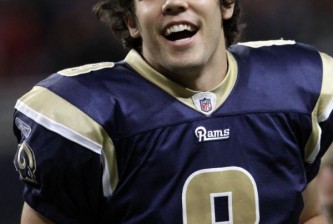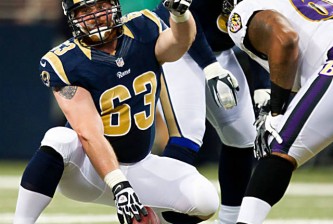The Rams’ post-draft offseason moves have been modest talent acquisitions, few of them designed to create major headlines — with the notable exception of the still-puzzling decision to drop Pisa Tinoisamoa. However, this latest move, acquiring Ronald Curry for back-of-the-DT-rotation Orien Harris, could actually provide significant impact on the team’s offense.
 Curry is a converted college quarterback who has developed into a reasonably reliable target — albeit on some of the worst offenses the NFL has ever known.
Curry is a converted college quarterback who has developed into a reasonably reliable target — albeit on some of the worst offenses the NFL has ever known.
Perhaps his best production came in his injury-shortened 2004 season. It was his third season in the league, a mythic milestone for breakout seasons. He benefited from the departure of the legendary Tim Brown and the breakdown of the even-more legendary Jerry Rice, lining up as a close #2 to Jerry Porter’s #1, and catching balls from aged Rich Gannon and the reasonably-competent Kerry Collins.
Ronald Curry’s NFL Career
| Season | games | Targets | Rec | Yards | TDs | Starting QB |
| 2002 | 1 | — | 0 | 0 | 0 | Rich Gannon |
| 2003 | 16 | — | 5 | 31 | 0 | Rich Gannon/ Rick Mirer |
| 2004 | 12 | 70 | 50 | 679 | 6 | Rich Gannon/ Kerry Collins |
| 2005 | 2 | 2 | 2 | 12 | 0 | Kerry Collins |
| 2006 | 16 | 89 | 62 | 727 | 1 | Andrew Walter/ Aaron Brooks |
| 2007 | 16 | 97 | 55 | 717 | 4 | Cade McNown/ Daunte Culpepper/ Jamarcus Russell |
| 2008 | 13 | 48 | 19 | 181 | 2 | Jamarcus Russell/ Andrew Walter |
I included the “Starting QB” header in this stat box, because I think it is remarkably telling. Marc Bulger will be the 9th quarterback in seven seasons for Curry to try to sync up with. (If it comes down to it, Kyle Boller would be the 10th.) And it may partially explain the growing disparity between his targets (i.e. the number of passes thrown his direction) and his receptions.
I asked Stu Rosenberg of Raiders Radar for his take on Curry, and whether the Rams have gotten a player that has something left to contribute. Stu is a former Raiders beat writer, and was happy to contribute his perspective. Here’s his response:
That both the Raiders and Lions passed on him is hardly a ringing endorsement, but Curry could actually work out for the Rams. The guy can bolt and he’s never had issues getting open. If teams focus all of their energies on Avery, Curry could become an inviting target for Bulger … that is, if Bulger can manage to stay upright behind that line. So, yeah, under the right circumstances, he could become a contributor.
Curry was picked up by the Lions as a free agent, after the Raiders showed about as much interest in him as Jamarcus Russell had on the field, but apparently decided to let him loose after acquiring Dennis Northcutt to play the slot.
At least one group may view the Curry as a positive sign for the Rams: in their 2009 Annual (which I highly recommend), Football Outsiders picked the Rams as a potential candidate for a surprise team, giving them fairly good chances of a 5- or 6-win jump up the standings. However, one of their main caveats, not surprisingly, was the Rams’ receiving corps. Or more specifically, the inexperience of our receiving corps:
Flipping then, to the chapter on the Chicago Bears, yields this analysis:
(If you aren’t familiar with their stats, DVOA is an approximation of a team’s productivity, where 0 equals a perfectly average team.)
So even if Curry does not become a world-beater, his mere presence — and a healthy 50 or more catches, with a handful of end zone grabs — could go a long way toward stabilizing this offense, and fueling hopes for the 2009 season.






















